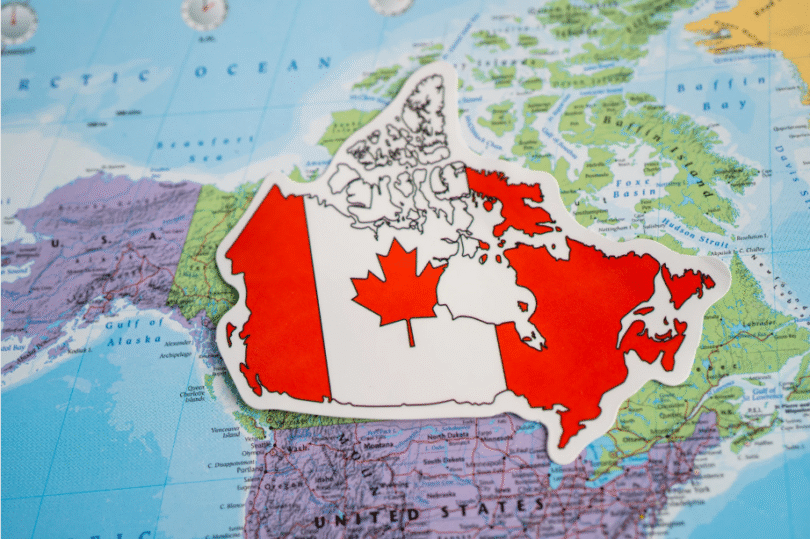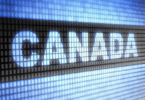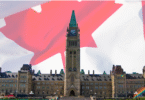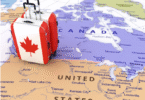Have you ever dreamed of visiting or living in Canada? You’re not alone! Canada is one of the most popular destinations in the world. People travel to Canada for many reasons; to study, work, reunite with family, or just explore its beautiful cities and natural wonders.
But before you pack your bags, there’s one important thing you need to do and that is get a Canadian visa. This little document is your permission to enter Canada legally. Without it, you may not be allowed to board your flight or enter the country at all.
In this guide, I’ll walk you through everything you need to know about applying for a Canadian visa. Whether you’re planning a short visit or a long stay, this article will help you understand the process.
What Is a Canadian Visa?
Before we jump into the application steps, let’s first understand what a Canadian visa really means.
A Canadian visa is a stamp or sticker placed inside your passport that shows you have been given permission to enter Canada. It is issued by the Canadian government and is needed by most people who want to:
- Visit for a short time (like a vacation or to see family)
- Study at a Canadian school or university
- Work in Canada
- Move to Canada permanently
Is a Visa the Same as a Ticket to Enter Canada?
Not exactly.
A visa gives you permission to travel to a Canadian port of entry (like an airport or land border). When you arrive, an immigration officer will check your documents and decide if you can officially enter the country.
So, think of it like this:
- Visa = permission to travel to Canada
- Entry = final approval when you arrive
Do I Need a Visa to Visit Canada?
It depends on your nationality.
Some people from visa-exempt countries (like the U.S. or many European countries) do not need a visa for short visits. But they still need an eTA (Electronic Travel Authorization).
Others, especially from African, Asian, or South American countries, must apply for a visa before traveling.
Tip: You can check if you need a visa by visiting the official Canadian government website: https://www.canada.ca
Types of Canadian Visas You Can Apply For
Not everyone goes to Canada for the same reason. Some people go to study, others go to work, and some just want to visit family or enjoy a vacation. Because of this, Canada offers different types of visas depending on your purpose.
Let’s look at the most common types of Canadian visas and what each one is for.
-
Visitor Visa (Tourist Visa)
This visa is for people who want to visit Canada for a short time.
You can apply for a visitor visa if you want to:
- Go on vacation
- Visit family or friends
- Attend a special event (like a wedding or graduation)
- Explore the country as a tourist
This visa is usually valid for up to 6 months. You cannot work or study with this visa, and you must show that you will return to your home country when your visit is over.
-
Study Permit
This visa is for people who have been accepted to a Canadian school, college, or university.
To get a study permit, you must:
- Have a letter of acceptance from a Canadian school
- Show that you can pay for your tuition and living expenses
- Have no criminal record
- Be in good health
This permit allows you to stay in Canada for the length of your study program. In most cases, students are also allowed to work part-time while studying.
-
Work Permit
If you have a job offer from a Canadian employer, you may be able to apply for a work permit.
There are two main types:
- Open work permit – You can work for almost any employer in Canada.
- Employer-specific work permit – You can only work for the employer listed in your permit.
To apply for a work permit, you may need a document called an LMIA (Labour Market Impact Assessment), which shows that no Canadian worker can fill the job.
-
Permanent Residency (PR)
This is for people who want to move to Canada permanently.
There are several programs under permanent residency, including:
- Express Entry (for skilled workers)
- Family Sponsorship
- Provincial Nominee Program (PNP)
- Refugees and humanitarian cases
PR holders can live, work, and study anywhere in Canada. After a few years, they can apply for Canadian citizenship.
-
Other Special Visas
There are a few other types of visas depending on your situation:
- Business Visa: For investors and business visitors
- Super Visa: For parents and grandparents of Canadian citizens or permanent residents
- Refugee Visa: For people escaping danger or persecution in their home country
- Transit Visa: If you’re passing through Canada on your way to another country
Step-by-Step Guide to Applying for a Canadian Visa
This guide works for most types of visas, especially the visitor, study, and work visas:
Step 1: Know What Type of Visa You Need
As we already discussed, there are different visas for different purposes. Before applying, make sure you understand:
- Why you are going to Canada
- How long you plan to stay
- What activities you plan to do (study, work, visit, etc.)
Example: If you’re going for a 3-month vacation, a Visitor Visa is perfect. If you’re going for university, you’ll need a Study Permit.
Step 2: Check If You’re Eligible
Each visa has its own requirements. But here are some general things you must have:
- A valid passport
- Proof of funds (money to cover your trip)
- A clean criminal record
- A good reason to return to your home country (like a job, school, or family)
- No health issues that would make you a danger to public health
You may also be asked to go for a medical exam or submit fingerprints (biometrics).
Step 3: Create an Online Account
To apply, you need to go to the official Canadian government website:
https://www.canada.ca
There, you’ll create a GCKey or Sign-In Partner account (it’s free). This is where you’ll fill your forms, upload documents, and check your visa status.
Step 4: Fill Out the Visa Application Form
Once you log in, you’ll need to fill the application form that matches your visa type.
For example:
- IMM 5257 for Visitor Visa
- IMM 1294 for Study Permit
- IMM 1295 for Work Permit
Make sure you:
- Answer all questions honestly
- Double-check your spelling and details
- Upload digital copies of your documents (passport, invitation letters, bank statements, etc.)
Step 5: Pay the Application Fee
After filling your form, you’ll be asked to pay the visa fee. This must be done online using a debit or credit card.
Sample fees (as of now):
- Visitor Visa: CAD $100
- Study Permit: CAD $150
- Work Permit: CAD $155
- Biometrics (if required): CAD $85
Make sure you download and save the receipt. You’ll need it later.
Step 6: Submit Your Biometrics (If Needed)
If it’s your first time applying, you may be asked to give biometrics — that means fingerprints and a photo.
- You’ll get a biometric instruction letter
- Visit a Visa Application Centre (VAC) near you to give your biometrics
- Do this within 30 days after receiving the letter
Tip: Book your biometrics appointment as soon as possible.
Step 7: Wait for Processing
Now, it’s time to wait. Visa processing times can vary based on:
- The type of visa
- Your country of residence
- The time of year (holiday seasons may be slower)
You can check the processing time online on Canada’s official site. During this period, immigration officers may ask for:
- More documents
- An interview
- A medical test
Step 8: Get a Decision
Once your application is reviewed, you’ll get a message in your online account:
- If approved: You’ll receive instructions to submit your passport for stamping
- If refused: You’ll get a letter explaining why
If approved, your visa will be stamped inside your passport, and you’ll be ready to travel!
Step 9: Travel to Canada
When traveling, make sure you carry:
- Your passport with visa
- Your approval letter
- All supporting documents (such as proof of funds, school acceptance, etc.)
At the Canadian airport or border, the immigration officer will:
- Ask you questions about your trip
- Check your documents
- Decide if you can enter
Stay calm, be honest, and answer clearly. If all is well, welcome to Canada!
Tips to Help Your Canadian Visa Application Succeed
Sometimes, it’s not just about applying, it’s about applying the right way. Many people get rejected not because they’re bad candidates, but because they didn’t prepare well.
Let’s give you some powerful tips to boost your chances of success:
Be Honest in Your Application
Always tell the truth in your form. If you lie or hide something, your visa might be:
- Refused
- Delayed
- Or even banned in the future
Even small lies (like your travel history or income) can cause big problems.
Show Strong Ties to Your Home Country
Canadian officers want to know that you will go back home when your visa ends unless you’re applying for permanent residence.
You can show this by providing proof like:
- A job letter or work ID
- School enrollment letter
- Property documents
- A letter from your family or community leader
- Return flight reservation (optional but helpful)
The goal is to show you have a reason to return home.
Give Enough Supporting Documents
Sometimes people submit only the basic things, but the more documents you give (within reason), the better.
You may include:
- Bank statements (to show you can support yourself)
- Letters of invitation from family/friends in Canada
- Hotel bookings
- A travel itinerary
- Proof of relationship (if visiting family)
Make Sure Your Documents Are Clear and Complete
Scan your documents properly. Avoid blurry pictures or cut-off pages.
- Use PDF format when possible
- Name each file clearly (like “Passport.pdf” or “BankStatement.pdf”)
- Double-check that nothing is missing before submitting
Apply Early
Don’t wait till the last minute. Apply at least 2-3 months before your travel date to give time for:
- Processing
- Biometrics
- Any additional requests from immigration officers
Follow All Instructions
Each visa type has different requirements. Read the checklist on the Canada.ca website carefully.
If you’re not sure, you can:
- Watch videos on the official website
- Contact a licensed immigration consultant
- Or ask questions at a Canadian Visa Application Centre (VAC)
Frequently Asked Questions (FAQs)
1. How long does it take to get a Canadian visa?
It depends on the visa type and your country. It can take 2 to 12 weeks on average. Always apply early.
-
Can I apply for a Canadian visa without an invitation letter?
Yes. You don’t need an invitation letter for all visas, especially tourist or student visas. But it can help if you have one.
-
Is the visa fee refundable if I’m not approved?
No. Visa fees are non-refundable, even if your application is denied.
-
Do I need a travel agent to apply?
No. You can apply yourself online at canada.ca. But if you need help, you can use a licensed immigration consultant.
-
What if my visa is refused?
You’ll get a refusal letter explaining why. You can fix the issues and apply again, or appeal in some cases.
-
Can I work in Canada with a Visitor Visa?
No. A visitor visa does not allow you to work. You must apply for a work permit if you want to work in Canada.
-
What documents do I need to prove I can pay for my trip?
You can use:
- Bank statements
- Payslips
- Sponsorship letters
- Or tax documents
-
Do I need a visa if I just want to transit through Canada?
Yes, in many cases you need a Transit Visa. It’s free, but you must apply before traveling.
Conclusion
Applying for a Canadian visa may seem like a long and serious process, but once you understand what is expected and follow the right steps, it becomes much easier to manage. The most important thing is to be honest, stay organized, and prepare your documents properly.
Canada welcomes people from all over the world, whether you want to study, visit, work, or even move permanently. The visa application process is there to make sure people meet the right requirements, not to scare you away. So don’t let fear or confusion hold you back.
Your journey to Canada is possible. Just believe in yourself, follow the guide, and start your application with confidence.






